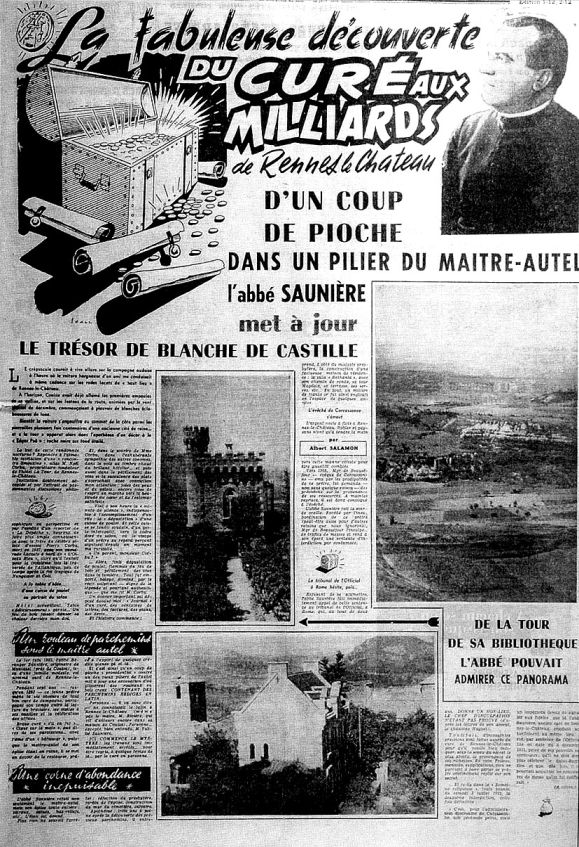PUT ONLINE 25.4.2024
La Dépêche du Midi
12 January 1956
THE AMAZING DISCOVERY BY THE “BILLIONAIRE PRIEST”
OF RENNES-LE-CHATEAU
(Part 1 of a 3-part series by Albert Salamon)
Part 1: A native of Carcassonne who was a contemporary of the Abbé says: “In one room of the château I saw boxes filled to the brim with gold ingots.”
[Captions:
Left: The apse of the church [words illegible] of the Lombards.
Centre: The current owner of the former residence of Abbé Saunière.
Right: The parchments of Blanche of Castile were found in a pillar just like this one. The illustration shows one of the two ‘feet’ of the altar. It was in a second one, which has now disappeared, that the parchments of Blanche de Castile were found.]
From the height of his pulpit the new priest of Rennes-le-Château delivered his sermon to a sparse congregation. Most of his parishioners had remained loyal to his predecessor and, while he preached to an almost empty church, they swarmed into the little chapel built on a veranda of the Villa Béthania...
How sad the abandoned altar looked to me, with its neglected figure of Christ, its statuettes covered in dust and, especially, the large portrait of the former master of this place, leaning forward with all his weight of disapproval towards the plastic flowers ravaged by time!
Within just a short time Saunière started to cut back slightly on his prodigalities. No doubt this was just to give him a breather before entering the fray once more to see what new unsuspected heights of extravagance he could ascend to.
Now we had truly arrived at the folie de grandeur stage.
On 5 January 1917 Saunière wrote to a leading local firm by registered mail ordering 8000 cubic metres of masonry, costing some 3 million francs in the money of the time.
And what works those were to be! Building a 50-metre tower from which Saunière could see all the way to Couiza, a library that ran the length of the spiral staircase to reach the entrance to the uppermost landing, taking responsibility for the complete renovation of the road from Couiza to Rennes, putting all the locals on mains water, and so on.
But then, suddenly, just 17 days later...
Saunière's death
On 22 January 1917, after a long death-agony, Saunière died in an armchair in his living-room...
“And which armchair was that, Monsieur Corbu?”
“The one you're sitting in!”
And while, as I must admit, a slight frisson ran through my body from head to toe I learned that Abbé Saunière had died in “my” armchair at the age of 65 of cirrhosis of the liver complicated by a heart attack, leaving all his quite staggering building-plans at the drawing-board stage.
All the splendours of château life...
The billionaire priest of Rennes lived life with a capital L.
The living-room of his sumptuous Villa Béthania was the scene for some quite incredible gastronomic delights.
All the local VIPs were given the chance to let out their waistbands and clink their goblets at this Rabelaisian Mecca – and many poorer people as well, for the Abbé's heart was huge and his wallet seemingly inexhaustible. They came from far afield and from the highest ranks of society to quench their thirst in the wine-cellar of this splendid country curate, a wine-cellar that he himself mischievously referred to as his “library.”
A wine-cellar like no other...
Saunière collected, along with their labels, the rarest and most delicious liqueurs from all over the world – from miniatures to litre-bottles.
From Jamaica and Martinique 50 to 70 bottles made their way to Rennes each month.
And what bills went with them! Let's have a look at one taken at random. “1st November 1900: 1 cask of Martinique spiced rum, crated, no. 1031 – 45 litres @ 2 francs = 90 francs.” And here's another one, followed by this mouth-watering comment: “Don't drink this one like water. It's a perfect rum, almost an historic one. 50 litres at 2 francs 35 centimes a litre = 117 francs 50 centimes.” Later on there's an invoice with a decidedly local flavour: “33 litres of Haut Barsac white wine, 33 litres Malvoisie, 17 litres orange Quinquina, 53 litres Banyuls, 12 litres Muscat, 11 litres Rancio...”
I'll bring this list of Pantagruelian sources of inspiration to a swift conclusion. [Bit missing here: about the ducks I think]... spoon-fed with biscuits to improve the tenderness of their flesh.
Mysterious journeys...
Such was the lifestyle of the former curé of Rennes, who always basked in the watchful and devoted attention of his loyal housekeeper, Mademoiselle Denarnaud.
Saunière also made mysterious trips to far-flung locations, including Switzerland, Spain and Belgium. Letters which he drafted in advance (and which were all identical) give us an insight into the explanations he gave for these repeated absences. It was the job of Mademoiselle Denarnaud, acting as Saunière's secretary, to ensure that the following brief missive was sent to whomever was making enquiry:
“Rennes-le-Château, Aude.
“Having been called upon at short notice to visit one of my colleagues, I must content myself for the time being with acknowledging receipt of your letter.
Respectfully, B. Saunière, priest.”
An answer to the question that you will no doubt already have asked yourself...
What exactly did Saunière get up to during these trips?
Monsieur Corbu has studied this important question extensively, and has no doubts on the matter:
“...why, he was disposing of the coins he had found of course. What's more,” Monsieur Corbu continues, “someone from Carcassonne who's still alive has assured me that he saw chests full of gold ingots at the Abbé's house.”
To be continued...
[END]

|
